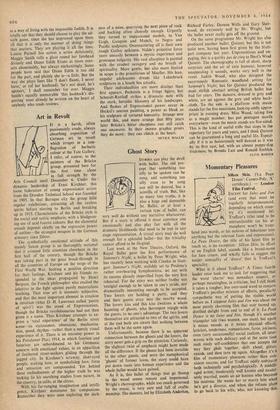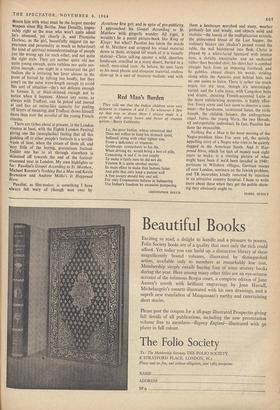Momentary Pleasures
Silken Skin. ('La Peau Douce': Cameo-Poly, 'X' certificate.) — London Film Festival.
EXCEPT for Jules and Jim (and even that must be regularly mispronounced, depending on which coun- try it's mentioned in), Truffaut's titles tend to be untranslatable (as his at- mosphere won't be trans- lated into words, or his notions of behaviour into anything but the relevant faces and expressions). La Peau Douce, the title of his latest film to reach us, is no exception: Silken Skin, its effort at an English label, sounds like a brand-name for face cream, and wholly fails to suggest the tender sensuality of `douce' that is Truffaut's speciality.
What is it about Truffaut? A Times fourth leader once took me to task for suggesting that the word 'charm' was nowadays suspect, or perhaps meaningless, in criticism, but I still think it takes a tougher, less over-used word to conjure Truffaut's peculiar mixture of effects, peculiarly sympathetic way of putting the visible world before us. I suppose Jules and Jim was about the most purely charming film that ever turned up, distilled delight from end to end of it. La Peau Douce is no Jules and Jim, though it's another triangular tale (two women, one man), but again it mixes moods as it mixes physical effects, lyricism, tenderness, romanticism, farce, jokiness, even (very occasionally) social realism, all inter- woven with such delicacy and at the same time such steely self-confidence that one accepts the way they glide together, shift about, glitter, vanish, and then turn up again. Altogether it's a film of momentary pleasures rather than con- sistent success, and for Truffaut oddly unbizarre both technically and psychologically. A middle- aged writer, moderately well known and moder- ately married, meets an air hostess who becomes his mistress. He wants her to marry him what he's got a divorce, and when she refuses plans to go back to his wife, who, not knowing thiS•
shoots him with what must be the largest murder Weapon since Big Bertha. Jean Desailly, impec- cably right as the man who won't quite admit he's obsessed, yet clearly is, and Francoise Dorleac, as the girl, beautifully suggest (in ap- pearance and personality as much as behaviour) the kind of spiritual misunderstandings of people Just the wrong age for each other, and not quite the right style. They are neither quite old nor quite young enough, quite ruthless nor quite sen- sitive enough : one night in a restaurant the girl realises she is irritating her lover almost to the point of hatred by talking too loudly, but they aren't on the same wave-length enough to avoid this sort of situation—she's not delicate enough to foresee it, or thick-skinned enough not to notice when it happens. Almost any scene, as always with Truffaut, can be poked and peered at and has an onion-like capacity for peeling off layers of meaning; and Truffaut shows himself more than ever the novelist of the young French cinema.
There are riches about at present, in the London cinema at least, with the Eighth London Festival giving one the (xenophobic) feeling that all this gadding off to other people's festivals is a terrible Waste of time, when the cream of them all, and very little of the boring, pretentious festival- fodder one has to sit through elsewhere is skimmed off towards the end of the festival- crammed year in London. My own highlights so far: Pasolini's Gospel According to St. Matthew, Michael Roemer's Nothing But a Man and Kevin Brownlow and Andrew Mollo's It Happened Here.
Pasolini, as film-maker, is something I have always felt wary of (though won over by Accattone first go); and in spite of pre-publicity, I approached his Gospel According to St. Matthew with gingerly wonder. All right, it wouldn't be a pastel picture-book like King of Kings: but what? Pasolini has taken the words of St. Matthew and stripped his visual material down to them, stripped till much of it is visually skeletal—Christ talking against a wild, cheerless landscape, crucified in a stony desert, buried in a small, man-sized cave. As before, he uses faces as his most plastic and eloquent material, endless close-up in a sort of majestic realism; and with them a landscape scorched and stony, weather pitilessly hot and windy, and objects solid and realistic--the loaves of the multiplication miracle, the nnleavened bread of the Last Supper, the ordinary beaker (no `chalice') passed round the table, the nail hammered into flesh. Christ is played by a white-faced Spaniard with intense eyes, a sketchy moustache, and an unshaved rather than bearded chin; his short hair is combed straight back from an imposing forehead, and he gabbles, almost chants his words, striding along while the Apostles pant behind him, and no one seems to listen. There is rather too much music for my taste, though it's interestingly varied, and the Luba mass, with Congolese boys and drums, shouting French-accented Latin at the more exhilarating moments, is highly effec- tive. Every scene and face seem to deserve a com- ment—the handsome, tormented Satan, the virile Joseph, the childish Salome, the androgynous angel, Judas, the young Mary, the two Herods, all unforgettably individual. In fact, Pasolini has done the impossible.
Nothing But a Man is the most moving of the Negro-problem films I've seen yet, the quietly appalling story of a Negro who tries to be quietly dogged in the American South. And It Hap- pened Here, which for lack of money took eight years to make, is a riveting picture of what might have been if we'd been invaded, in 1940: partisans in Wiltshire villages, German troops all over London, seminars on the Jewish problem, and TB incurables kindly removed by injection in an attractive country hospital. I hope to write more about these when they get the public show- ing they obviously ought to.

































 Previous page
Previous page